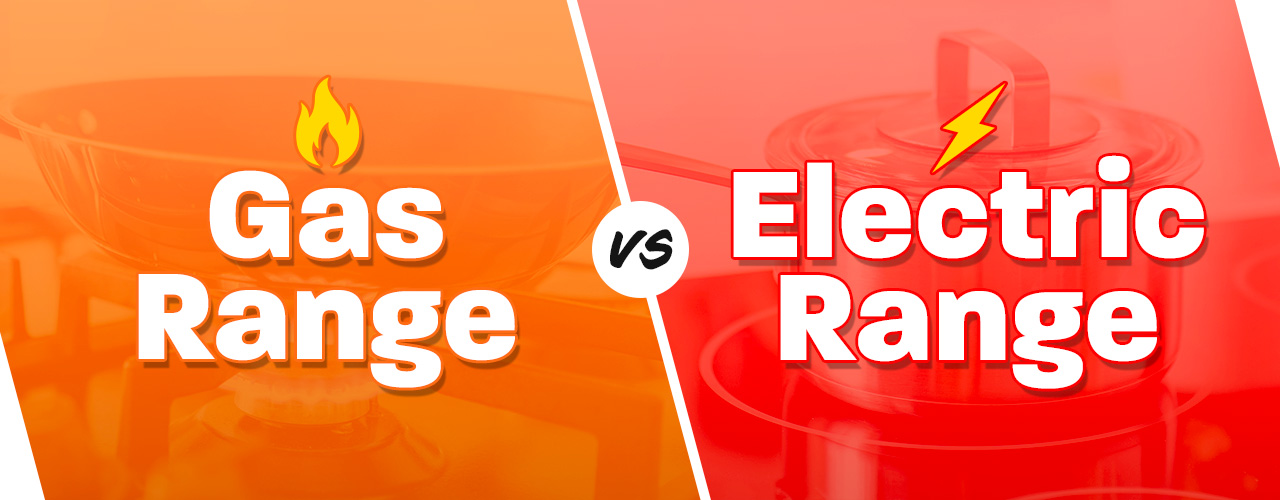
Whether you’re buying equipment for your new restaurant or replacing worn-out equipment, every operator must make the crucial decision between investing in a gas or electric range. Consider factors such as heat control, heat distribution, and the types of dishes you typically prepare when deciding which type of range is best suited for your commercial kitchen. We walk you through the key considerations of choosing between each heat source and explain how both units work so you can make an informed purchasing decision.
Shop All Commercial RangesGas vs Electric Range

Electric ranges often provide more even heat distribution than gas ranges. However, gas ranges offer more responsive heat control. This means that chefs can adjust the heat levels quickly and precisely, allowing for more immediate changes in cooking temperature. This feature can be particularly advantageous when cooking dishes that require precise temperature control or when searing meats.
In terms of ovens, the dry, even heat produced by electric range ovens may work better for baked goods, such as cakes and pastries. The consistent heat distribution in electric ovens can help ensure even baking and prevent hot spots that may occur in gas ovens, making them a better choice for commercial bakeries. Ultimately, the choice between a gas or electric range will depend on your specific cooking needs and preferences.
What Is a Gas Range?

A gas range requires a dedicated gas line and uses an open flame to fuel both the oven and the stovetop. The stovetop typically features different types of gas burners that offer various heat levels, allowing chefs to have optimal control over cooking temperatures. This flexibility is essential for precise cooking techniques that require different heat intensities. In the oven, the flame cycles on and off to maintain ideal cooking temperatures.
Pros of Gas Cooking
Review the advantages of cooking with gas to see if it would be the best choice for your foodservice business:
- Instant Heat: Gas burners provide immediate heat, allowing for quicker cooking times and precise temperature control.
- Even Stovetop Heat Distribution: Gas burners distribute heat evenly across the bottom of pots and pans, reducing the risk of hot spots and ensuring consistent cooking results.
- Versatility: Gas cooktops offer a wide range of heat settings, making them suitable for various cooking techniques such as simmering, searing, and boiling.
- Energy Efficiency: Gas is generally more cost-effective than electricity, making gas cooking a budget-friendly option for commercial kitchens.
- Easier Maintenance: Gas cooking equipment typically has fewer parts compared to electric models, making it easier to maintain and repair. This can help reduce downtime and ensure that your kitchen stays operational.
Cons of Gas Cooking
Gas cooking equipment is a great choice for commercial kitchens, but many operations benefit from electric options. Check out these cons of gas cooking before making your selection:
- Installation Costs: Gas cooking equipment typically requires professional installation and may involve additional costs for gas line connections.
- Ventilation Requirements: Gas cooking produces combustion byproducts that need to be properly vented to ensure indoor air quality and safety.
- Flame Control: Burners offer precise heat control, but adjusting the flame can be challenging for inexperienced users.
- Safety Concerns: Gas appliances pose a higher risk of gas leaks and fire safety hazards compared to electric appliances, requiring regular maintenance and monitoring.
- Uneven Oven Cooking: Gas ovens may have hot spots or uneven heat distribution, which can result in inconsistent baking results. Chefs may need to rotate baked goods or adjust baking times to ensure even cooking.
What Is an Electric Range?

An electric range utilizes heated metal coils to transfer heat to cookware, providing a consistent and even cooking experience. These metal coils are not only used on the stovetop but also inside the oven, ensuring that the entire cavity maintains a steady temperature for optimal cooking results. The use of metal coils in electric ranges is known to result in consistent temperatures throughout the oven, making them a reliable choice for bakeries. Unlike gas ranges, electric ranges have a smooth, flat cooking surface that is easy to wipe down and maintain. The absence of open flames or gas burners means that there are no nooks or crevices where food particles can accumulate, making cleaning a quick and straightforward task.
Pros of Electric Cooking
There are many benefits of cooking with electric appliances. We've rounded up the top highlights so you can evaluate whether electric is a good fit for your needs:
- Ease of Use: Electric cooking appliances are typically easier to use compared to gas appliances. They often feature precise temperature controls, making it easier to cook delicate dishes.
- Safety: Electric stoves do not produce an open flame, reducing the risk of gas leaks and fire hazards. This makes them a safer option for kitchens with limited ventilation.
- Easy to Clean: Electric stoves are generally easier to clean than gas stoves since they have smooth, flat surfaces that can be wiped down quickly. This speeds up your restaurant cleaning process at the end of each day.
- Lower Initial Cost: In many cases, electric cooking appliances have a lower initial cost compared to gas appliances, making them a budget-friendly option for businesses.
Cons of Electric Cooking
While there are many advantages of cooking with electric appliances, we also want you to be educated about their drawbacks. Review the primary cons below:
- Slower Heating: Electric stoves typically take longer to heat up compared to gas stoves, which can lead to longer cooking times.
- Higher Utility Costs: Electric cooking can be more expensive in the long run due to higher electricity costs compared to natural gas.
- Limited Portability: Electric cooking appliances require a dedicated electrical outlet, limiting their portability compared to gas appliances that can be used with propane tanks, making gas appliances better for caterers.
- Less Control Over Temperature: Electric stoves may have a slower response time when adjusting temperature settings, which can be a drawback for chefs who require precise control over cooking temperatures.
- Reliance on Electricity: In the event of a power outage, electric cooking appliances will not function, potentially disrupting kitchen operations.

How to Switch from Gas to Electric Stove
Switching from a gas stove to an electric stove in a commercial kitchen can be a significant decision that requires careful planning and consideration. While both gas and electric stoves have advantages and disadvantages, making the switch to an electric stove can offer several benefits. By following these steps and considerations, you can switch from a gas to an electric stove in your commercial kitchen, taking advantage of the benefits that electric cooking can offer.
- Assess Your Kitchen Setup: Before making the switch, evaluate your current kitchen setup to determine if it can accommodate an electric stove. Consider factors such as the availability of electrical outlets, the voltage requirements of the electric stove, and the space needed for installation.
- Consult with a Professional: It is recommended to consult with a licensed electrician or a professional kitchen equipment installer to ensure that the electrical system in your kitchen can support the new electric stove. They can also provide guidance on any necessary upgrades or modifications that may be required.
- Select the Right Electric Stove: When choosing an electric stove, consider factors such as the size of the stove, the number of burners needed, and any additional features that may be beneficial for your commercial kitchen. Look for energy-efficient models that can help reduce operating costs in the long run.
- Installation Process: Once you have selected the electric stove, schedule the installation with a qualified technician. The installation process may involve wiring the stove to the electrical system, ensuring proper ventilation, and testing the stove to ensure it is functioning correctly.
- Training Staff: It is important to train your kitchen staff on how to operate and maintain the new electric stove. Electric stoves may have different heat settings and cooking times compared to gas stoves, so providing proper training can help ensure efficient and safe cooking practices.
- Safety Considerations: Electric stoves require different safety precautions compared to gas stoves. Make sure to educate your staff on the potential hazards associated with electric stoves, such as electrical shock and burns, and provide guidelines on how to safely use and clean the stove.
How to Switch from Electric to Gas Stove
When transitioning from an electric stove to a gas stove in a commercial kitchen, there are several important steps to follow to ensure a successful conversion. By following these steps and working with experienced professionals, you can successfully switch from an electric to a gas stove in your commercial kitchen.
- Schedule an Appointment with a Licensed Plumber: Before making any changes, it is crucial to consult with a licensed plumber who specializes in gas line installations. They will assess your kitchen's layout, determine the best location for the gas stove, and ensure that all safety regulations are met.
- Run New Gas Lines or Install a Natural Gas Line: If your kitchen does not already have gas lines in place, the plumber will need to run new lines or install a natural gas line. This step is essential for providing the gas supply needed to power the stove.
- Modify the Electrical Wiring: Since electric stoves require a different power source than gas stoves, you will need to modify the electrical wiring in your kitchen.
- Install a Ventilation System: Gas stoves produce combustion gases that need to be properly ventilated to ensure a safe working environment. Installing a ventilation system, such as a hood or exhaust fan, is necessary to remove any fumes or odors generated during cooking.
- Set Up the Gas Stove: Once the gas lines, electrical wiring, and ventilation system are in place, it's time to set up the gas stove itself. Follow the manufacturer's instructions for installation, ensuring that the stove is securely connected to the gas supply and properly calibrated for cooking.
- Train Staff on Safety and Use: Before using the new gas stove, it is essential to train your staff on safe and efficient operation. Make sure they understand how to ignite the burners, adjust the heat settings, and shut off the stove in case of an emergency. Emphasize the importance of proper ventilation and gas safety protocols to prevent accidents.
Ultimately, the choice between gas and electric cooking equipment will depend on your kitchen's specific needs, budget, and infrastructure. Consider factors such as energy efficiency, cooking performance, installation requirements, and long-term maintenance costs before making a decision. By carefully evaluating these factors, you can choose the right type of cooking equipment that best suits your commercial kitchen's needs.





